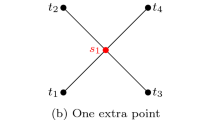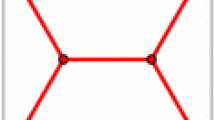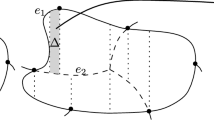Abstract
This paper has two purposes. The first is to present a new way to find a Steiner minimum tree (SMT) connectingN sites ind-space,d >- 2. We present (in Appendix 1) a computer code for this purpose. This is the only procedure known to the author for finding Steiner minimal trees ind-space ford > 2, and also the first one which fits naturally into the framework of “backtracking” and “branch-and-bound.” Finding SMTs of up toN = 12 general sites ind-space (for anyd) now appears feasible.
We tabulate Steiner minimal trees for many point sets, including the vertices of most of the regular and Archimedeand-polytopes with <- 16 vertices. As a consequence of these tables, the Gilbert-Pollak conjecture is shown to be false in dimensions 3–9. (The conjecture remains open in other dimensions; it is probably false in all dimensionsd withd ≥ 3, but it is probably true whend = 2.)
The second purpose is to present some new theoretical results regarding the asymptotic computational complexity of finding SMTs to precision ɛ.
We show that in two-dimensions, Steiner minimum trees may be found exactly in exponential time O(C N) on a real RAM. (All previous provable time bounds were superexponential.) If the tree is only wanted to precision ɛ, then there is an (N/ɛ)O(√N)-time algorithm, which is subexponential if 1/ɛ grows only polynomially withN. Also, therectilinear Steiner minimal tree ofN points in the plane may be found inN O(√N) time.
J. S. Provan devised an O(N 6/ɛ4)-time algorithm for finding the SMT of a convexN-point set in the plane. (Also the rectilinear SMT of such a set may be found in O(N 6) time.) One therefore suspects that this problem may be solved exactly in polynomial time. We show that this suspicion is in fact true—if a certain conjecture about the size of “Steiner sensitivity diagrams” is correct.
All of these algorithms are for a “real RAM” model of computation allowing infinite precision arithmetic. They make no probabilistic or other assumptions about the input; the time bounds are valid in the worst case; and all our algorithms may be implemented with a polynomial amount of space. Only algorithms yielding theexact optimum SMT, or trees with lengths ≤ (1 + ɛ) × optimum, where ɛ is arbitrarily small, are considered here.
Similar content being viewed by others
References
A. V. Aho, M. R. Garey, and F. K. Hwang: Rectilinear Steiner trees: Efficient special case algorithms,Networks,7 (1977), 37–58.
M. Ajtai, V. Chvatal, M. M. Newborn, and E. Szemeredi: Crossing free subgraphs,Ann. Discrete Math.,12 (1982), 9–12.
S. K. Chang: The generation of minimal trees with a Steiner topology,J. Assoc. Comput. Math.,19 (1972), 699–711.
F. R. K. Chung and E. N. Gilbert: Steiner trees for the regular simplex,Bull. Inst. Math. Acad. Sinica,4 (1976), 313–325.
F. R. K. Chung and R. L. Graham: A new bound for Euclidean Steiner trees,Ann. N. Y. Acad. Sci,440 (1985), 328–346.
E. J. Cockayne: On Fermat's problem on the surface of a sphere,Math. Mag.,45 (1972), 216–219.
E. J. Cockayne and D. E. Hewgill: Exact computation of Steiner minimal trees in the plane,Inform. Process. Lett.,22 (1986), 151–156.
U. Derigs: A shortest augmenting path method for solving minimum perfect matching problems,Networks,11 (1981), 379–390.
D. Z. Du: On Steiner ratio conjectures, manuscript, Inst. Appl. Math. Academia Sinica, Beijing, China, 1989.
D. Z. Du: The Steiner ratio conjecture is true for six points, to be published.
D. Z. Du, F. K. Hwang, and J. F. Weng: Steiner minimal trees for regular polygons,Discrete Comput. Geom.,2, 1 (1987), 65–87.
H. Edelsbrunner:Algorithms in Combinatorial Geometry, EATCS Monographs in Theoretical Computer Science, Springer-Verlag, Berlin, 1987.
J. H. Friedman, J. L. Bentley, and R. A. Finkel: An algorithm for performing best matches in logarithmic expected time,ACMTOMS,3, 3 (1977), 209–226.
M. R. Garey and D. S. Johnson: The complexity of computing Steiner minimum trees,SIAM J. Algebraic Discrete Methods,32 (1977), 835–859.
M. R. Garey and D. S. Johnson: The rectilinear Steiner minimum tree problem is NP-completeSIAM J. Algebraic Discrete Methods,32 (1977), 826–834.
E. Gekeler: On the solution of systems of equations by the epsilon algorithm of Wynn,Math. Comp.,26, 118 (1972), 427–436.
G. Georgakopoulos and C. H. Papadimitriou: The 1-Steiner tree problem,J. Algorithms, 8 (1987), 122–130.
E. N. Gilbert and H. O. Pollak: Steiner minimal trees,SIAM J. Appl. Math.,16 (1968), 1–29.
R. L. Graham and F. K. Hwang: Remarks on Steiner minimal trees I,Bull. Inst. Math. Acad. Sinica,4 (1976), 177–182.
M. Hanan: On Steiner's problem with rectilinear distance,SIAM J. Appl. Math.,14 (1966), 255–265.
K. Heibig-Hansen and J. Krarup: Improvements of the Held-Karp algorithm for the symmetric TSP,Math. Programming,7 (1974), 87–96.
M. Held and R. M. Karp: The traveling salesman problem and minimum spanning trees,Oper. Res.,18 (1970), 1138–1162.
M. Held and R. M. Karp: The traveling salesman problem and minimum spanning trees, part II,Math. Programming,1 (1971), 6–25.
J. E. Hopcroft and R. E. Tarjan: Efficient planarity testing,J. Assoc. Comput. Math.,21 (1974), 549–558.
F. K. Hwang: A linear time algorithm for full Steiner trees,Oper. Res. Lett.,5 (1986), 235–237.
F. K. Hwang and D. S. Richards: Steiner tree problems, Bell Laboratories, Murray Hill, NJ, Technical Memorandum 1989. To be published inNetworks.
F. K. Hwang, G. D. Song, G. Y. Ting, and D. Z. Du: A decomposition theorem on Euclidean Steiner minimal trees,Discrete Comput. Geom.,3, 4 (1988), 367–392.
F. K. Hwang and J. F. Weng: Hexagonal coordinate systems and Steiner minimal trees,Discrete Math.,62 (1986), 49–57.
F. K. Hwang and J. F. Weng: The shortest network with a given topology, Bell Laboratories, Murray Hill, NJ, Technical Memorandum 1988.
A. N. C. Kang and D. A. Ault: Some properties of the centroid of a free tree,Inform. Process. Lett,4, 1 (1975), 18–20.
B. Kernighan and D. Ritchie:The C Programming Language, Prentice-Hall, Englewood Cliffs, NJ, 1978.
J. R. Kruskal Jr.: On the shortest spanning subtree of a graph and the traveling salesman problem,Proc. Amer. Math. Soc.,7, 1 (1956), 48–50.
H. W. Kuhn; On a pair of dual nonlinear programs, in:Methods of Nonlinear Programming, pp. 38–54, Ed. J. Abadie, North-Holland, Amsterdam, 1967.
H. W. Kuhn: A note on Fermat's problem,Math. Programming,4 (1973), 98–107.
E. L. Lawler, J. K. Lenstra, A. H. G. Rinnooy Kan, and D. B. Schmoys (eds.)The TST, A Guided Tour of Combinatoral Optimization, Wiley-Interscience, New York, 1985.
Z. A. Melzak: On the problem of Steiner,Canad. Math. Bull.,4 (1961), 143–148.
G. L. Miller: Finding small simple cycle separators for 2-connected planar graphs,J. Comput. System Sci.,32 (1986), 265–179.
J. Milnor: On the Betti numbers of real algebraic varieties,Amer. Math. Soc.,15 (1964), 275–280.
C. Monma, M. Paterson, S. Suri, and F. Yao: Computing Euclidean maximum spanning trees, ACM Computational Geometry Conference 1988, pp. 241–251.
F. P. Preparata and M. I. Shamos:Computational Geometry: An Introduction, Springer-Verlag, New York, 1985.
R. C. Prim: Shortest Connection Networks and Some Generalizations,Bell System Tech. J.,36 (1957), 1389–1401.
J. S. Provan: Convexity and the Steiner tree problem,Networks,18 (1988), 55–72.
P. W. Shor and W. D. Smith: Steiner hulls and θ-hulls, manuscript, 1989.
W. D. Smith: Studies in Discrete and Computational Geometry, Ph.D. Thesis, Program in Applied and Computational Mathematics, Princeton University, September 1988.
D. Smith: Finding the optimum traveling salesman tour forN sites in the Euclidean plane in subexponential time and polynomial space,SIAM J. Comput., submitted.
J. M. Smith, D. T. Lee, and J. S. Liebman: A O(N 1gN) algorithm for Steiner minimal tree problems in the Euclidean metric,Networks,11 (1981), 23–29.
J. Soukup: Minimum Steiner trees, roots of a polynomial, and other magic,ACM SIGMAP Newsletter,22 (1977), 37–51.
R. P. Stanley: The number of faces of simplicial poly topes and spheres, in: Discrete Geometry and Convexity,Proc. N. Y. Acad. Sci., (1986).
R. E. Tarjan: Data structures and network algorithms, CBMS-NSF Regional Conference Series in Applied Mathematics, vol. 44, Society of Industrial and Applied Mathematics, Philadelphia, PA, 1983.
J. V. Uspensky:Theory of Equations, McGraw-Hill, New York, 1948.
B. L. van der Waerden:Algebra, Ungar, New York, 1970.
H. E. Warren: Lower Bounds for approximation by nonlinear manifolds,Trans. Amer. Math. Soc., 133 (1968), 167–178.
P. Winter: An algorithm for the Steiner problem in the Euclidean Plane,Networks,15 (1985), 323–345.
Author information
Authors and Affiliations
Additional information
Communicated by F. K. Hwang.
Rights and permissions
About this article
Cite this article
Smith, W.D. How to find Steiner minimal trees in euclideand-space. Algorithmica 7, 137–177 (1992). https://doi.org/10.1007/BF01758756
Received:
Revised:
Issue Date:
DOI: https://doi.org/10.1007/BF01758756




